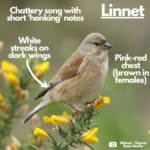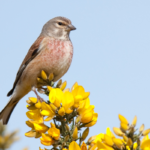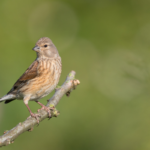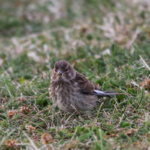Linnet

Back Nightjar Dartford Warbler Woodlark Stonechat Linnet Tree Pipit
LINNET
Linaria cannabina
Often associated with areas of gorse, Linnets occur on heathlands, as well as farmland. The females are mostly brown, with tiny streaks of white edging on the wings and tail, while the males are more readily recognisable with a grey head and a crimson chest and forehead in the breeding season. Usually when you see linnets the male and female are close together in a pair, rather than singly.
- Male linnet perched on flowering gorse
- Female linnet
- Linnet feeding
[Click on the thumbnails to open]
Where/when to find them
Linnets are most easily seen in the breeding season when they perch on top of low gorse bushes. This is when the red on the males is most prominent.
Adaptations
Linnets flock together in winter on farmland, often with other small birds, to make locating food easier in the lean winter months and to get protection in numbers from predators.
Diet
Mostly small seeds and insects.
Rarity
Overall numbers of Linnets are higher across the country than the three rare heathland bird species (Dartford Warbler, Woodlark and Nightjar), but they are becoming an increasingly uncommon sight as their numbers are declining. Under the traffic light system of Birds of Conservation Concern, they are ‘red’ listed (i.e. of the highest conservation priority), with the species needing urgent action to reverse its decline.
Read more
Birding beginnings: Listening out for Linnets
#MoreThanJustNightjars




